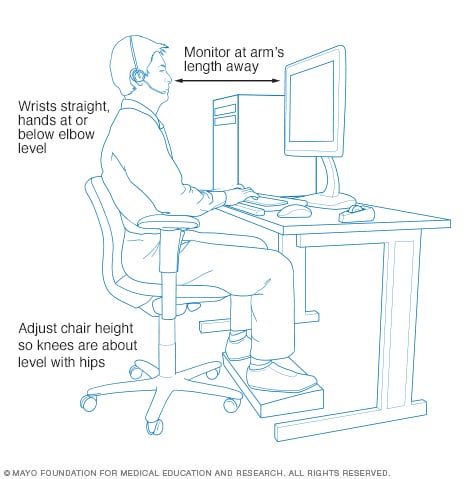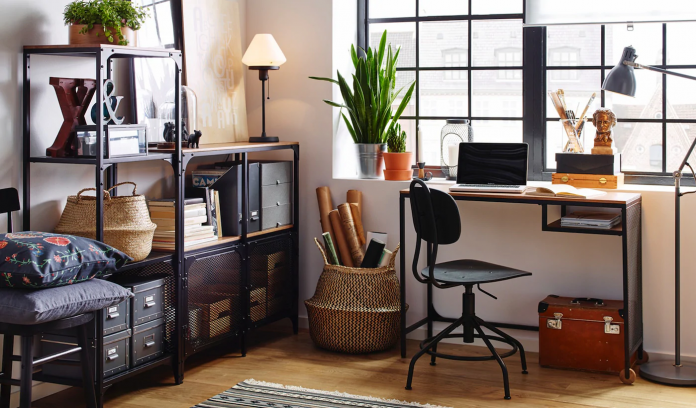If you’ve spent your Work From Home (WFH) days working from your bed or slouching over your dining table, you may be causing irreversible damage to your back and other spinal muscles.

Using proven ergonomic principles, this is a guide on how you can work from home in comfort while maximising productivity by making small (but VERY important) changes. We’ve also included some popular home office tech devices/equipment if you feel like an upgrade is due.
What Is Workplace Ergonomics?

Workplace ergonomics is the science of designing a workplace that improves your efficiency and comfort when carrying out job duties. If you’re spending most of your day in front of a computer, even small adjustments may help reduce the risk of long-term damage and injuries. Comfort aside, this will also help increase your productivity.
Now that you know what workplace ergonomics is, read on for our list of home office tech that complements our ergonomic tips to improve the way you work from home!
Things You Never Knew Your Home Office Needed:
1. Adjustable Office Chair
If backaches have been the bane of your home office existence, a good office chair can make a difference to having good posture. Sitting for long periods puts pressure on the back muscles and spinal disc and this is worsened by our tendency to slouch.
As we spend the bulk of our time sitting, a bad chair could cause long-term spinal damage resulting in chronic back pain.
A good chair for your home office should have:
-
- Adequate back support. The lower back has a slight forward curve (lumbar curve). Good support means some kind of contour or cushion that prevents you from slouching forward as you get tired over time.
- Adjustable height. A poorly adjusted chair height may be the reason you slouch over more or find yourself straining your neck.
- Adjustable arm rests. Other than adjustable height, the arm rest should also be able to swivel inward so that you can rest the length of your arm when you are typing.
- Good material. If you’re a serial butt-sweat-imprinter, look for chairs with mesh or breathable materials.
Ergonomic tip: Keep your back straight with elbows close your body. Keep both feet on the ground, with your thighs parallel to the floor. If your chair if not adjustable, use a footrest to support your feet as needed.
Most Popular Chair Based On Our Research: Secret Lab Omega

The Ferarri of office chairs, this one has been hailed the best by gamers for a long time but recently gained mainstream popularity.
2. Keyboard
Your choice of keyboard will largely depend on personal preference. Things to consider include:
-
- Features. Depending on how often you move around, a wireless keyboard may prove to be useful to some. Another feature to look out for is the N-key rollover, a feature that allows for accurate detection of keys.
- Ergonomic design. The alignment of the common keyboard requires unnatural twisting of the wrists. This easily leads to muscles strains over long periods of typing. Ergonomic keyboards have been developed to conform to the natural positions of our hands. However, just making sure that your keyboard is at a neutral height for your wrist should be sufficient for reducing strain.
- Travel. Keyboards with lesser travel distance means you don’t have to press all the way down for the key to register, which allows you to type faster. Laptops generally have a much shorter travel distance than desktop keyboards.
Ergonomic tip: The best position for your keyboard will be level with your elbows, and your wrists should not be pressing against a hard edge. Keeping your wrists neutral will also help avoid injury, and is the reason why ergonomic keyboards often have keys wider apart – so your hands and wrists can be straight as you type.
3. Mouse
:max_bytes(150000):strip_icc()/AnkerAK-UBAWirelessVerticalMouse-5b4cea0dc9e77c005b8d59dc.jpg)
Your laptop’s track-pad was not designed for prolonged use, so you might want to consider investing in an ergonomic mouse. Vertical mice have been all the rage because they conform to our hands’ natural “hand-shake” position.
Some ergonomic tips for using your mouse in the least straining way:
-
- Keep your wrist in neutral position
- Keep your mouse at level with your elbows
- Use whole arm movements rather than relying on rotating your wrists
- Don’t linger or grip your mouse when you’re not using it – Try to keep your hands flat on your desk as the default position
4. Monitor
A good monitor isn’t going to magically eliminate the damage of staring at the screen for hours on end, but it can reduce that damage by making certain provisions. The reasons why screens tire your eyes out are:
-
- Glare. Reduce the brightness of the screen to a comfortable level, and reposition the monitor to reduce light reflection. There are ways to compensate for the glare, such as blue light glasses (added bonus of looking extra hardworking on those Zoom meetings) or anti-glare screens.
- Low Definition. Reading letters on a screen that are less sharply defined may cause an imperceptible strain on the eyes that lead to fatigue.
What we recommend when using a monitor is the 20-20-20 rule: After staring at the screen for 20 minutes, look away at something at least 20 feet away (about 6 meters) for 20 seconds. Set an alarm for 20 minutes as a reminder – the short break for your eyes could do wonders for productivity.
Ergonomic tip: Your monitor should be placed directly in front of you, roughly at an arm’s length away. Ensure that the top of your monitor is at eye level or just below. This will allow you to maintain a good posture while working.
Most Popular Monitor Based On Our Research: PRISM+ W240 24” ($249)

A popular option that ticks all the boxes is the PRISM+, boasting features such as adjustable blue light and anti-flicker technology that will significantly reduce the strain on your eyes.
5. Desk

There are all kinds of ergonomic desks out there if you’re ready to splurge – the adjustable desk has been popular because you can move between standing and sitting, but really most desks will work as long as they aren’t too high or low. Adjustable monitor/chair heights will compensate accordingly.
Are you a work from home expert now?
With the ergonomic tips you’ve learnt and the home office tech recommendations, go forth and WFH like your life depends on it!



















